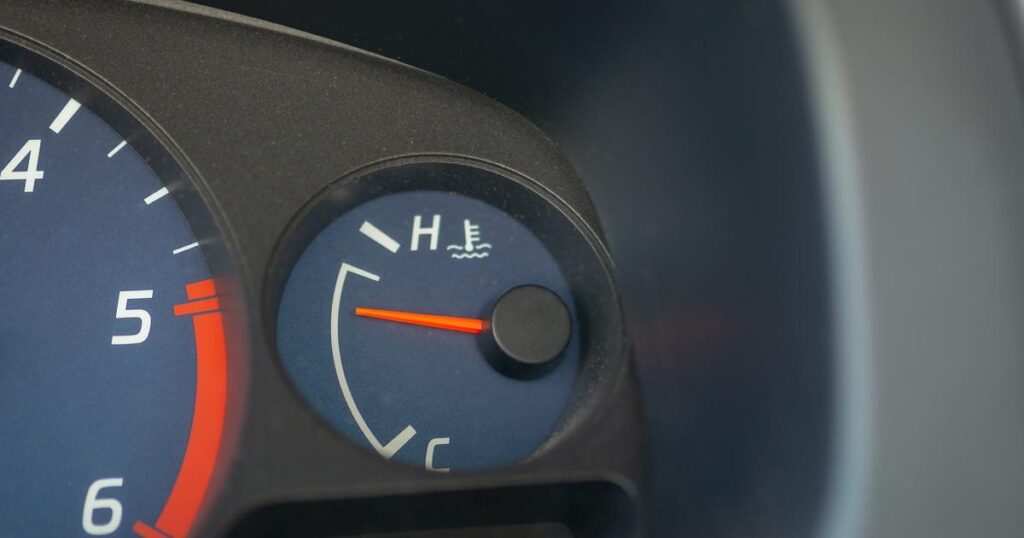What to do when your car overheats
When your car overheats, it’s not just an inconvenience—it’s a potential emergency that can seriously damage your engine. Understanding why overheating occurs and knowing what steps to take can save you not only from hefty repair bills but also keep you safe on the road.
Key Takeaways:
- Immediate Actions: Turn off the air conditioner and turn on the heater to help cool the engine.
- Do Not Overlook: Never continue driving an overheating car.
- Preventative Checks: Regularly check your coolant levels and engine’s cooling system.

Understanding Why Cars Overheat
An overheating engine can occur for several reasons such as a malfunctioning thermostat, a leak in the cooling system, or a problem with the water pump. Common indicators that your car is overheating include steam coming from under the hood, a spiking temperature gauge, and an illuminated temperature warning light.
Immediate Steps to Take When Your Car Overheats
- Turn Off the AC and Turn On the Heater: This might seem counterintuitive, but turning on the heater draws heat away from the engine.
- Pull Over Safely: As soon as you notice the temperature gauge rising or steam emerging, find a safe place to pull over.
- Turn Off the Engine: Once safely parked, turn off the engine to prevent further damage.
- Wait for the Engine to Cool: Open the hood if it’s safe to do so to help the engine cool down faster, but never open the radiator cap while the engine is hot.
- Check and Add Coolant if Necessary: If the coolant is low, adding more might help, but remember this could be a temporary fix if there’s a significant leak or another issue.
Preventative Maintenance
Regular checks on your vehicle’s cooling system are crucial. Ensure your coolant levels are adequate and look for any signs of leaks or damaged hoses. It’s advisable to have your cooling system inspected by professionals regularly to prevent overheating issues.
If you’re dealing with a low coolant light or suspect your coolant levels are low, it’s crucial not to ignore these warnings as they can indicate a leak or a failing component in your cooling system.
Handling Overheating on the Road
If your car overheats while you’re driving, especially in traffic, the safest thing to do is pull over and call for assistance. Continuing to drive with an overheating engine can cause catastrophic damage, including a blown head gasket or even a seized engine, which are expensive repairs.
Understanding the basics of your car’s cooling system, and knowing what to do when something goes wrong, can help you manage an overheating incident without panic. Regular maintenance and prompt attention to any warning lights can significantly reduce the risk of serious damage, ensuring that your vehicle runs efficiently and safely.

Long-Term Solutions to Prevent Overheating
Keeping your car from overheating not only involves immediate responses but also ongoing maintenance and preventative measures to ensure your vehicle remains in top condition.
Regular Cooling System Maintenance
- Coolant Flush: Replacing old coolant and cleaning the system to remove buildup and contaminants that can hinder cooling efficiency.
- Thermostat Check: Ensuring that the thermostat functions correctly to regulate coolant flow and engine temperature.
- Inspect Radiator and Hoses: Checking for leaks, cracks, or wear in the radiator and hoses that can lead to coolant loss and overheating.
Upgrade Cooling Components
If you frequently encounter overheating issues, consider upgrading parts of your cooling system:
- High-Performance Radiator: Provides better cooling capacity for demanding environments.
- Water Pump Upgrade: Ensures more efficient coolant circulation.
Monitoring and Diagnostics
- Regular Temperature Checks: Keep an eye on your vehicle’s temperature gauge, especially during high temperatures or when driving in stressful conditions.
- On-Board Diagnostics: Utilize tools to read codes from your car’s computer system, particularly if the check engine light comes on. This can indicate overheating issues before they become apparent.
Frequently Asked Questions
What causes a car to overheat?
Car overheating can be caused by several issues, including low coolant levels, failed thermostat, clogged hoses, or a malfunctioning radiator.
Can I drive my car after it overheats?
It is not recommended to continue driving an overheated car. Doing so can cause severe damage to the engine. Always allow the engine to cool down and address the underlying issue first.
How do I know if my car’s cooling system needs maintenance?
Signs that your cooling system needs maintenance include fluctuating temperature gauge readings, visible coolant leaks, or steam emitting from the engine.
What should be included in a coolant system service?
A complete coolant system service should include flushing the old coolant, checking for leaks, inspecting and possibly replacing hoses, and assessing the radiator and water pump condition.
Preventive Measures and Tips
In addition to the mechanical aspects of preventing overheating, consider these practical tips:
- Avoid Idling: Long periods of idling can cause the engine temperature to rise.
- Optimize Airflow: Make sure the front of your radiator is clear of debris that can block airflow.
- Enhanced Cooling Additives: Some coolants come with additives that help enhance the cooling properties and protect against corrosion.
Understanding the intricacies of your vehicle’s cooling system and the preventative measures available can greatly reduce the likelihood of experiencing serious issues like overheating. Regular maintenance, immediate action when issues arise, and being equipped with the right information and tools are your best defense against costly repairs and dangerous situations on the road.
